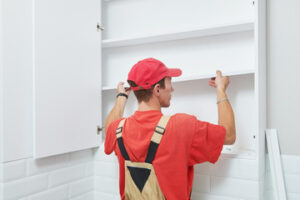When it comes to installing shelves, there are many different things you need to keep in mind. For example, you’ll need to determine the exact location of the shelves and how to fit them in. You’ll also need to consider how to mount the shelves and how to make them look nice.
If you are planning to hang shelves in your home, make sure you know how to measure off the floor. A good rule of thumb is to hang them about four to five feet off the floor. For heavier shelving, you may wish to anchor them in studs. You can use toggle bolts or “L” brackets to secure them.
To determine the best measurement for your needs, take the height of the shelves you intend to put up, along with the width of the room. Also, take into account the weight of the items you are displaying on the shelves. Floating shelves are tricky, and you can easily lose a book or two. They can also sag and obstruct your view if not properly installed.
The wall above your sofa should be about 10 inches above the couch. This is not always feasible, but the rule of thumb is that you want to place the shelf in a way that it does not interfere with the use of the couch.
Make sure you have a good drywall or plasterboard base. It is not necessary to drill holes in the drywall, but it does help to get a good fit.
After you have the base in place, you can start the fun part. Cut a sheet of plywood into the size you need. You can do this with a circular saw or a table saw. Repeat this process on the bottom of each shelf frame. Use a level to ensure your shelf is straight.
Another useful tidbit to note is that you can use a stud finder to get a better idea of where the studs are. Once you have identified the location of the studs, you can use drywall anchors or hollow-wall anchors to hold the shelf in place.
Using the right drill bit is a crucial step in ensuring shelf brackets are attached securely. There are many tools available to help you get the job done.
First, choose a drill bit that is not too large. A basic drill bit kit should leave about sixteenths of an inch between sizes. This is to avoid the screw cylinder diameter being too large.
Next, you must determine the studs in the wall. It may be helpful to mark the studs with a pencil. These marks will make it easier to install the shelves. If you don’t have a stud finder, you can use masking tape to mark the studs.
Once you know where the studs are, you can pre-drill the holes for the shelf brackets. Then, you can secure the brackets to the wall with long wood screws.
You’ll need a level to ensure the shelves are level after the brackets are attached. You can use a level tool or hold a straight 2 x 4 on the wall.
For a decorative shelf, you can use paper patterns. You can then flip the pattern over and trace the rest of the board.
Make sure to mark the corresponding pilot holes. They are important to prevent the material from splitting. In addition, they will help you see where the screws are.
For a heavier object, such as a shelf, you may need to drill three holes 16 inches apart. Alternatively, you can use L-brackets. But you must take into account the stud spacing and make sure the shelves will fit.
If you are installing shelves on drywall, you can use a drywall anchor. Toggler brand drywall anchors slide down cable ties and seat against the other side of the drywall.
If you want to hang shelves in your home, you need to know how to secure them. There are several methods to do so, including the use of anchors, glue, and tape.
To begin, you need to make sure that the studs in your walls are strong enough to hold the weight of your shelf. Use a stud finder to locate studs. This is an important step because a free-standing bookshelf can tip over easily or even fall over during a large earthquake.
Another option is to install hollow-wall anchors. These are great for a heavy shelf. Hollow-wall anchors are available at hardware stores. Alternatively, you can use screws to secure the shelf.
If you prefer to use a lighter shelf, you can use light-duty anchors or screws. Both can be found at any hardware store. For heavier shelves, you may need to buy additional mounting hardware.
